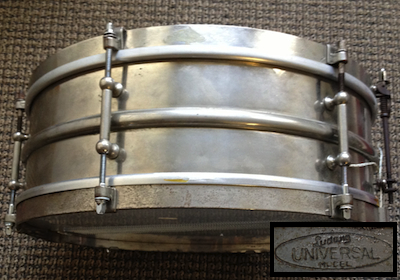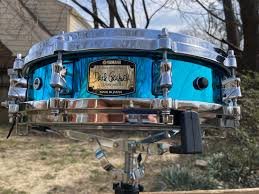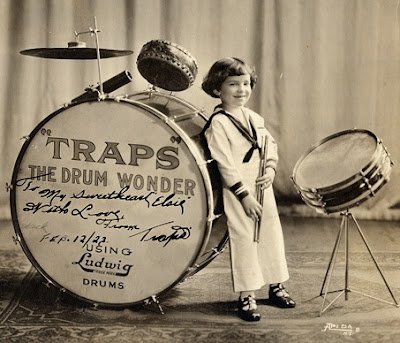An excerpt from my forthcoming book, “On Drumming Well”.
Snare Drum construction, timbre, tuning, heads and snare wires.



I was involved with the Not So Modern Drummer Snare Drum Olympics contest three times. The first time, I was invited by then owner John Aldridge to be a judge in the nineties. Later, after I became the owner of NSMD, I held the Olympics during the weekends of the two NSMD Vintage Drum Shows that were held in Nashville in 2012 and 2014. Manufacturers and custom builders would send in their drums to be judged in a blind and a subjective audition and the winners would have bragging rights in their advertising. There were many categories of different drum construction materials; wood, metal, synthetic, etc. Inevitably, a brass drum would win the overall “best in show” award. Why? Because they were the brightest sounding. I remember listening to dozens of drums being played behind my back in that first contest. After the first few, they all started sounding the same. Ear fatigue would set in quickly - until - the brass drum category came up. We judges were allowed to buy any drum we wished. I remember almost all the judges raising their hands and saying, “I’ll buy that one” when a really great sounding brass drum was played. That first year it was the World Max Black Dawg brass drum that won. I bought the Pearl Sensitone Premium brass that won the 2014 contest.
Thin shell brass drums have been popular with drum set players since the invention of the drum set. The snare is the highest voice in a set of drums. To my ear, brass shells place the snare in the right pitch and timbre register for a drum set. I have preferred two types of drums over the decades; thin brass shells in shallow depths, and deeper one piece steam bent wood shells with re-rings like Slingerland Radio Kings and the Noble & Cooleys. My Famous brand drums that my step son Evan Thomas and I make and sell are Radio King shell construction.
My philosophy on snare drum tone and tuning is that the snare drum heads should be tuned as tight as possible, top and bottom. The shell will provide the most responsive and optimal tone with the heads tuned “tight as a drum”. Buddy Rich said, "I don't tune them, I tension them. There's a great difference” and, of course, he had the archetypical snare drum sound, especially after the advent of plastic heads. After I bought the Garibaldi snare, I asked my former house mate in Nashville, Rich Russo, how Garibaldi tunes his snare and what heads and wires he was using. Rich was the stage manager and drum tech for Tower of Power at the time. He said, “Coated ambassador, and clear diplomat bottom. Yamaha snare wires. Tuned extremely tight to the point that it almost doesn’t sound good anymore. With one moongel on top.”
One of the purposes of the snare drum is to activate the snare wires; to get the snappiest, brightest sound possible from them. This is achieved by tuning the heads extremely tight. This also takes the drum out of the range of ‘sympathetic snare wire buzzing’ from other instruments and the toms. The tighter the snare and wires, the less buzzing. De tuning a small drum takes it out of its optimal tonal range. If you require a “Don Henley” deep tuning then you should use a deep drum, thick heads and lots of muffling – basically a “prepared” snare drum for a special effect. Don’t expect to play Sousa or jazz on a dead drum. The snare drum is the highest voice in the drum set - the soprano voice. The default ground zero snare sound is a high pitched bright sound – then tune or detune from there.
Now, I am not saying that every drum should be tuned like this or that I know everything there is to know about tuning drums, but I do speak from experience and I am advising you to try it at least once with all your snare drums. When I was running George’s Drum Shop, I tuned a lot of snare drums for my customers. I found that tuning them extremely tight would cure a lot of ills in drums that were ringing, buzzing, had bad snare response, etc. Most of my customers were surprised at how much better their drums sounded with tight tuning. How tight? Well, as my friend Bill Ray says, “So tight that it starts screaming for its lawyer”! :-)
I recently bought two snares: a 3.5 x 14 Yamaha brass David Garibaldi snare which is no longer made, and a 4x14 1924- ish six lug Ludwig & Ludwig Universal model two piece brass snare. The Garibaldi snare is my favorite drum for performances, mainly because it speaks with no effort; it does not have to be hit hard to produce a loud report. It is a high, dry sound and the die cast aluminum hoops allow me to play loudl rim shots when needed. But, I consider the L&L to be the better sounding drum. It, to me, is the archetypical snare drum sound; bright, high pitched, snappy, and with a degree of fragility in the sound that is appealing. It has single flanged hoops and is not meant for rim shots.
Buddy Rich, when asked what kind of snare drum he liked, reminisced and said something along the lines of “Mr. Ludwig made a great drum”. He was speaking of his first Ludwig drum(s) that he performed with as a young child in the vaudeville theatres which were the same basic shell as this 1924 drum that I have. I’ve seen pictures that show him as a child with this drum and also with an enamel white 8 lug model. The video is from a recording made when he was 12 years old for a film “short”. The film is long gone but the vitaphone disc remains. Scary.
The L&L shell is a two piece shell. The two halves are welded together at the bead, one tucked inside the other. The top and bottom edges have an extra flange which is welded back to the inside of the shell – this forms a hollow triangle. It is the rigidity of this triangle which makes it the perfect bridge for transferring the vibrations of the head to the shell. Rigid ends with a thin shell seems to be the formula for a great sounding drum with lots of harmonics in its tone whether it be wood or metal. This is why thin shelled wood drums with reinforcing rings have such rich harmonics and “throat”.
I’ve had several of these twenties Ludwig brass drums over the year, my favorite being an eight lug 4x15 Theatre model which I wish I had never sold (see video below at 36 minutes). That drum was proclaimed the “best sounding snare drum I’ve ever heard” by all the many drummers who played it while I owned it. They are all the same basic shell construction as the Ludwig black beauties of that era. This 6 lug Universal model is a “poor man’s black beauty”. I bought this current drum for a pretty low price. $250. It’s in good working condition. I had a couple of these 6 lug models in the past and was never satisfied with their sound. I realized with this latest one that the fault had been mine; the wrong heads and snare wires, thus the wrong tuning. I recommend that you buy one of these as a staple in your snare drum arsenal. They are comparatively cheap and no other drum replicates the sound.
I discovered that it was not sounding its best until I experimented with different heads and snare wires. Which brings me to the main point of this article. Finding the the right heads and snare wires are a process which most drummers do not learn. Most drummers are brand loyal to one of the big three or four manufacturers. I endorse Evans drum heads and they work for 99% of my needs, but I don’t necessarily use an Evans product if another brand or type works better. In particular, on this drum, the Evans snare side head was sounding duller than I preferred. Also, the 14 strand Ludwig snares (not original) were not sitting right and not sounding right. I ordered a PureSound 12 strand vintage wire set. I replace the bottom head with a Remo ambassador snare side. Voila, the magic combination. The narrow snare beds on this drum were meant for gut snares. The flat spot on the beds are only an inch wide. That flat spot determines what width your snare wires should be. When the metal plates on the ends of the snares are not aligning within the flat spot on the edge of the drum, then the wires will not seat in the curve of the head properly. In this case, the snare wires needed to be two strands narrower.
These opinions and five dollars will buy you a cup of coffee at Starbuck’s. They may also lead to compliments on your snare drum sound.
